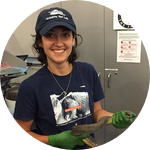About This Project
Ophidiomycosis (snake fungal disease) is a threat to snake health. Caused by the fungus Ophidiomyces ophiodiicola, it affects over 30 wild snake species and can cause skin abnormalities, internal lesions, and even death. Differences in disease signs may be due to snakes' response to infection. We plan to measure innate immune function in Lake Erie watersnakes with a range of ophidiomycosis lesions to determine if disease severity is associated with immune function.
Ask the Scientists
Join The DiscussionWhat is the context of this research?
Ophidiomycosis was first identified in 2003 and affects more than 30 species of wild snakes in at least 34 states in the US as well as in Europe. It has been associated with at-risk species, including Timber rattlesnakes, massasauga rattlesnakes, and eastern indigo snakes. The disease was diagnosed in Lake Erie watersnakes in 2009 and up to 55% of these snakes are affected. Differences in innate immunity may explain why some snakes are more severely affected than others. As the primary defense against infection in reptiles, innate immunity can be assessed through the lysis of sheep red blood cells by serum complement proteins and the activity of chitotriosidase, an enzyme that breaks down chitin and is associated with antifungal defenses in alligators.
What is the significance of this project?
Ophidiomycosis can affect all snake species, so it is critical to know why snakes are variably susceptible in order to design conservation programs that protect snake health. Snakes benefit humans by controlling populations of rodents and ticks that carry zoonotic diseases and benefit global health by maintaining biodiversity. Snake populations worldwide are declining due to climate change, habitat destruction, and infectious disease, among other factors, and little is known about the reptile immune system, particularly the response to fungal infection. This project will directly benefit Lake Erie watersnakes, which have a high prevalence of ophidiomycosis and only recently recovered from critically low population numbers.
What are the goals of the project?
In summer 2019, we will capture 40 Lake Erie watersnakes with a range of skin lesions (10 unaffected, 10 mild, 10 moderate, 10 severe) and (1) collect blood for innate immune function testing, (2) swab the snakes’ skin for quantification of the fungal load, and (3) record lesion number, type, size, and location on the body. Serum will be tested for chitotriosidase activity and lysis of sheep red blood cells. DNA will be extracted from swabs and qPCR will be used to quantify the amount of fungus present on each snake's skin. Finally, the lesion characteristics will be used to assign a disease severity score. All of these observations will be analyzed in fall 2019 to determine if there is an association between innate immune function and severity of disease.
Budget
This project will be conducted as part of an ongoing collaboration between the Wildlife Epidemiology Lab and the Ohio State University’s Stone Lab to monitor the health of Lake Erie watersnakes. We are currently conducting multiple projects to determine the prevalence and impacts of ophidiomycosis (snake fungal disease). We have external funding for travel and accommodations during field work. The first budget item covers the reagents and sheep red blood cells needed for the serum complement and chitotriosidase assays, which will allow us to quantify innate immune function. The second item covers the cost of DNA extraction from skin swabs and qPCR to quantify the fungal load on the snakes’ skin. This will allow us to confirm the presence of O. ophiodiicola, the causative agent of ophidiomycosis, and compare the fungal load to the severity of visible disease and innate immune function.
Endorsed by
 Project Timeline
Project Timeline
Blood and swab samples will be collected during fieldwork conducted between May 28 and June 7, 2019. Samples will be processed in the lab during July and August, then results will be compiled and analyzed. Statistical analysis and report preparation will occur in September and October of 2019.
Jun 03, 2019
Project Launched
Jun 07, 2019
Collect samples during field work on Lake Erie islands
Jun 28, 2019
Extract DNA from swabs
Jul 19, 2019
Run qPCR on swab-extracted DNA
Aug 16, 2019
Run assays to assess innate immune function
Meet the Team
Affiliates
Ellen Haynes
I've always been interested in science and wanted to dedicate my career to the conservation of animals and the environment. I decided to become a veterinarian to help wild animals whose lives have been negatively impacted by human actions. I received my BS in Animal Science from Cornell University in 2009 and my DVM from Cornell University College of Veterinary Medicine in 2013. After graduation, I completed internships in small animal and wildlife medicine, then worked as the veterinarian at a wildlife sanctuary for 2 years before completing my PhD at the University of Illinois in Ecology, Evolution, and Conservation Biology from the University of Illinois Urbana-Champaign. My PhD work focused on the epidemiology of ophidiomycosis (snake fungal disease), specifically investigating treatment options, host response to infection, and pathogen genomic variation. As a Postdoctoral Research Associate in the Cleveland Lab at SCWDS, I am involved in projects on Guinea Worm transmission and ophidiomycosis surveillance in the state of Georgia.
Project Backers
- 37Backers
- 110%Funded
- $2,541Total Donations
- $65.97Average Donation




